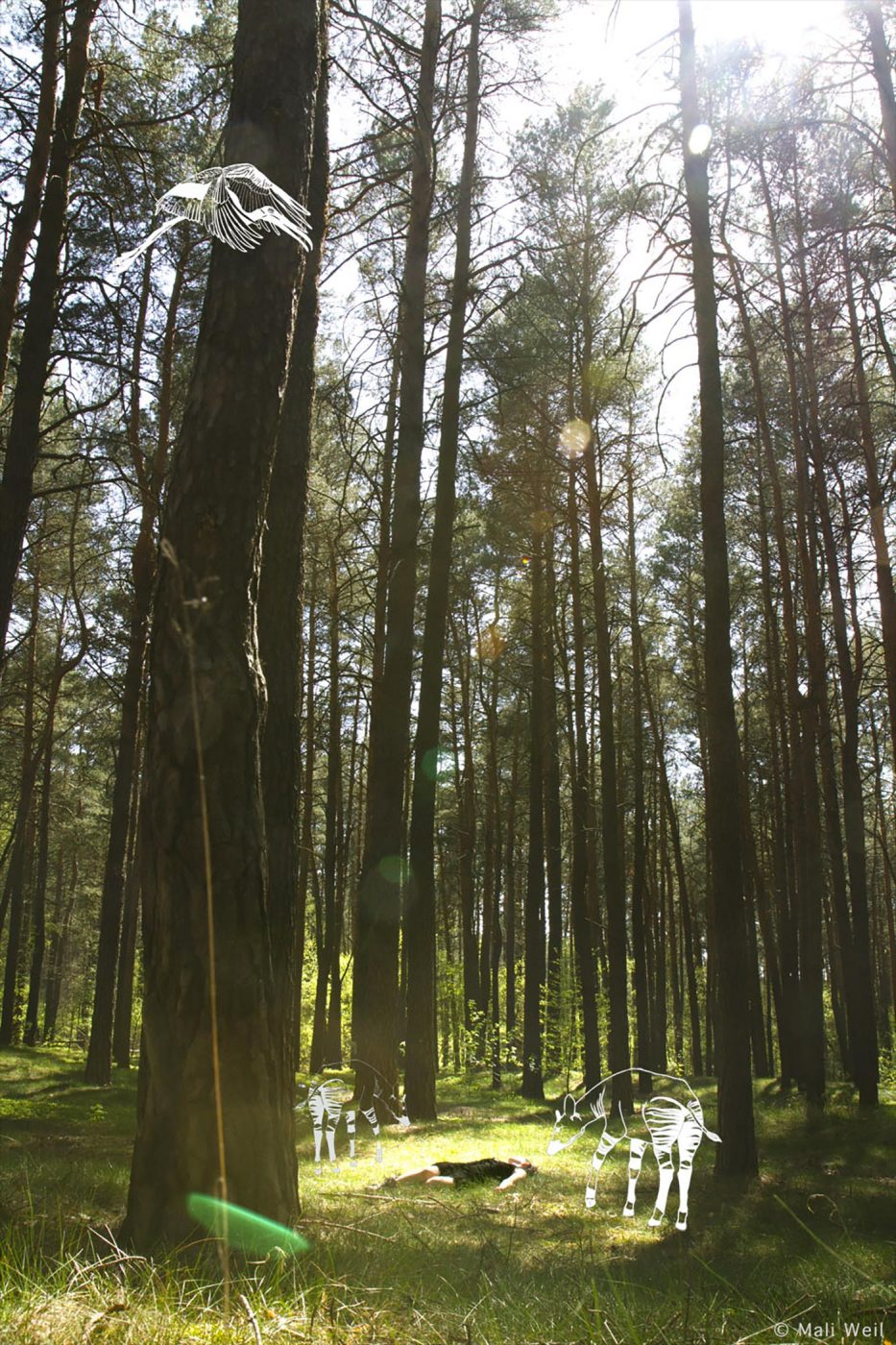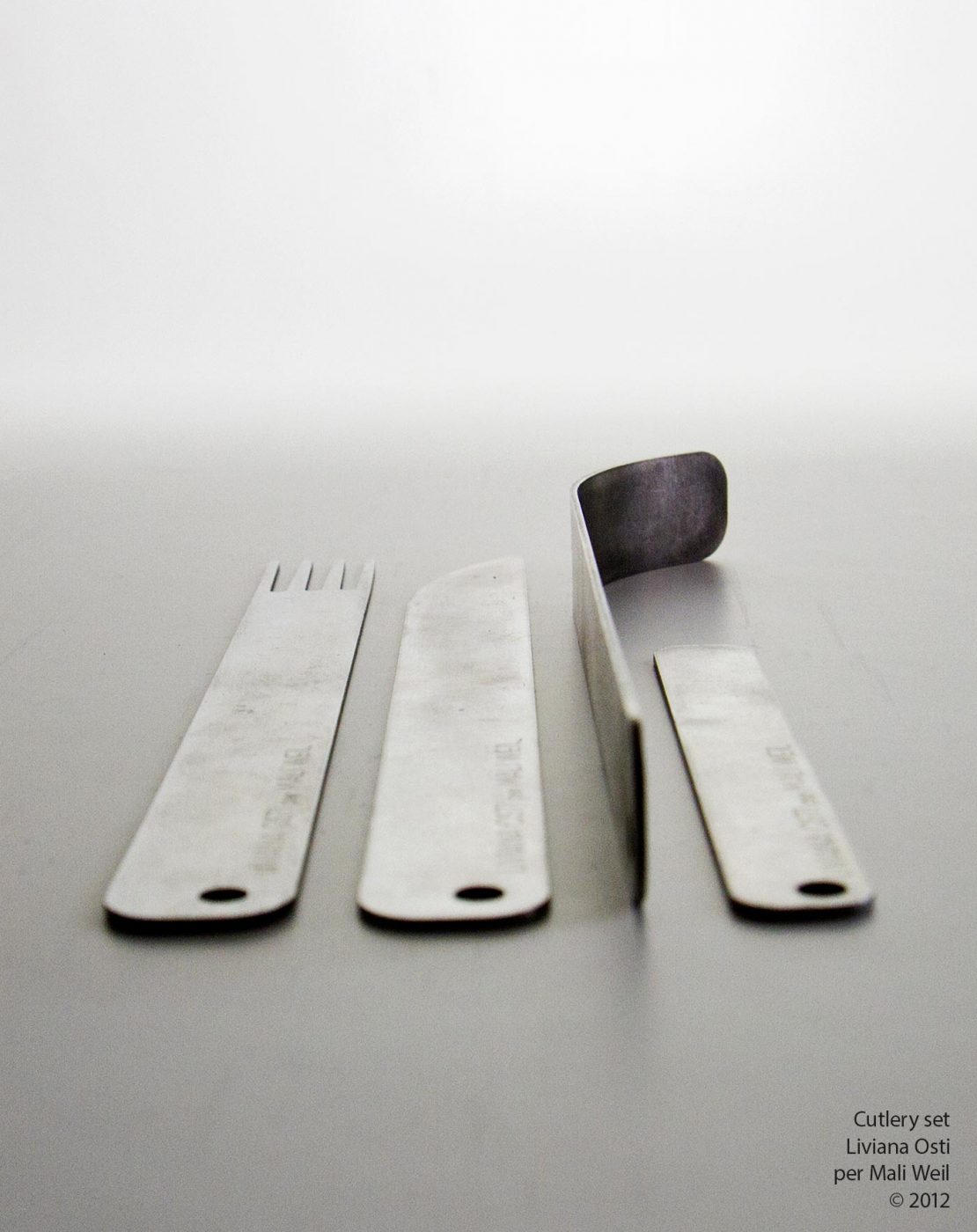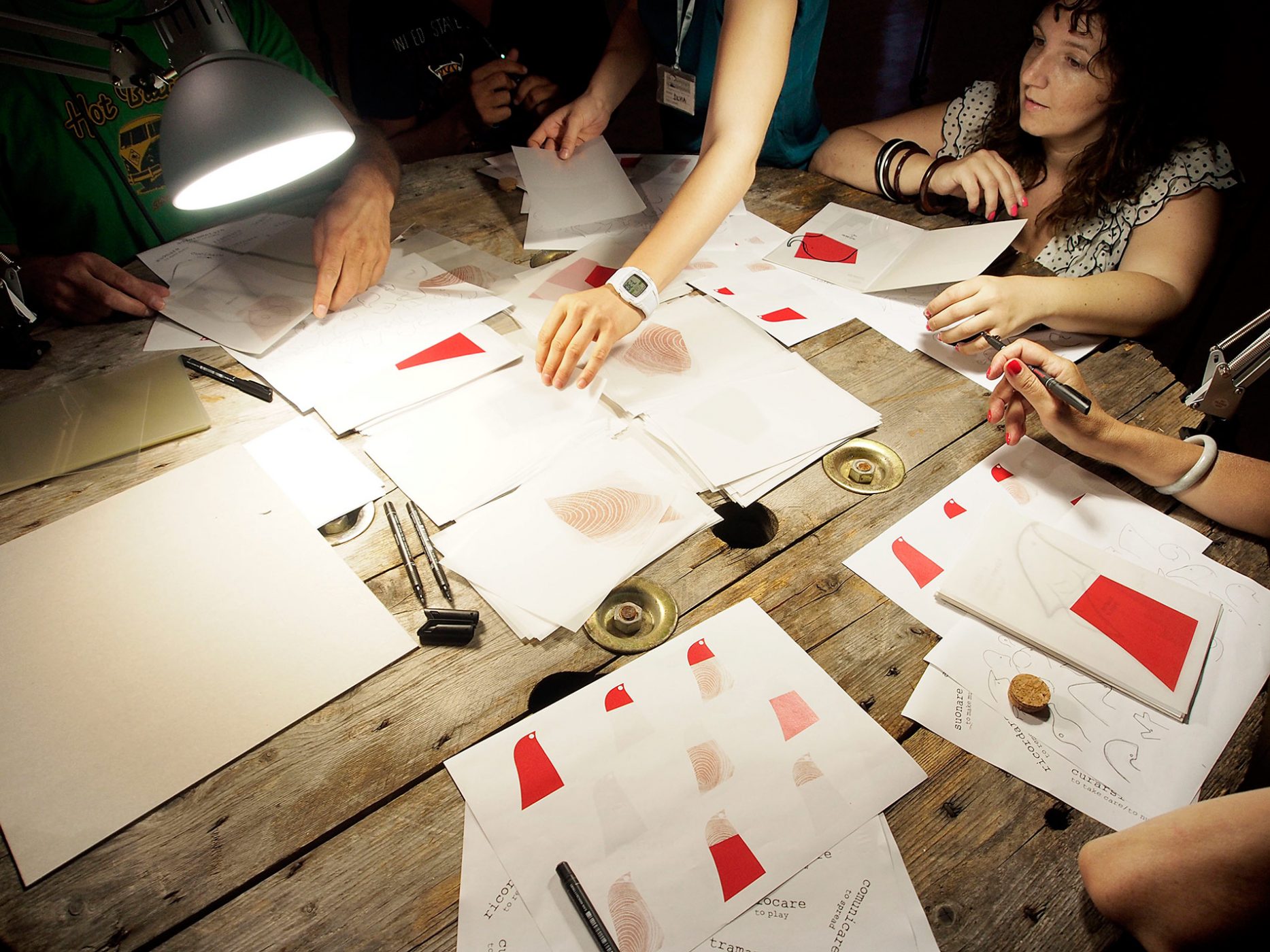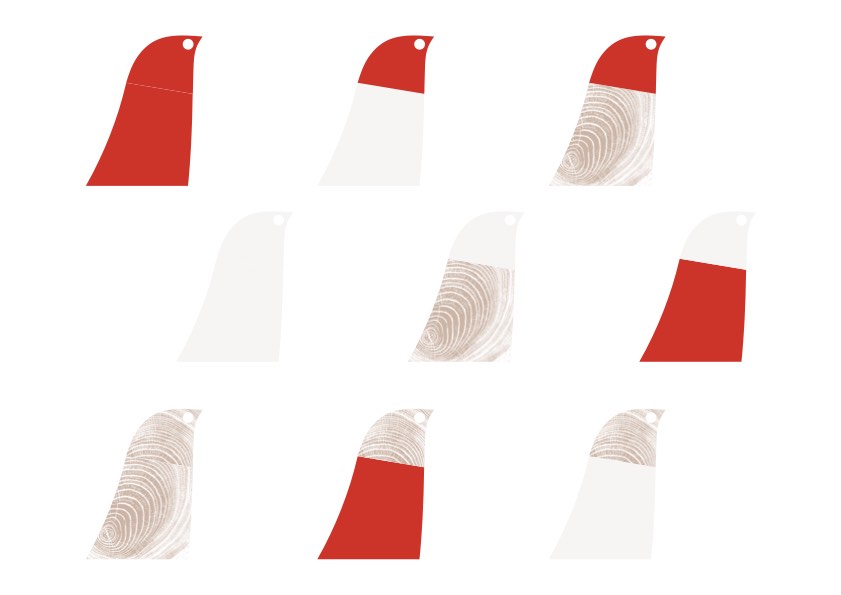WHITE NOISE MACHINE
2012
design:
Liviana Osti, Silvia Vettoretti
live sound design:
Elettra Bargiacchi
production:
Mali Weil, Centrale Fies
with the support of:
Provincia Autonoma di Trento,
Comune di Trento,
Fondazione Caritro
The White Noise Machine is a temporary office which aims to produce White Mama. This is not only a design object conceived by designer Liviana Osti specifically for Mali Weil, but also a customizable Totem, able to guard private bonds and individual mythologies.
With the help of a designer, visitors are invited to create their personal White Mama and make a private bid in order to win an auction for its realization. No money offers are admitted. On the contrary, the most distant offer from the current economical logic will win the auction. A commission composed of economists will evaluate the best offer.
In this temporary office, Mali Weil is working on design as an iconic practice, trying to extrude it from the economic context and to connect it to the production of myths, visions and lateral thinking.
IT
La White Noise Machine è un temporary office il cui scopo è produrre White Mama. Il White Mama è insieme un oggetto di design creato da Liviana Osti per Mali WEil ed un totem personalizzato, capace di custodire legami e mitologie individuali.
Ogni visitatore può progettare il proprio White Mama, ma solo uno se ne aggiudica la realizzazione: colui che vince un’asta cui si partecipa attraverso un’offerta in busta chiusa. Non sono però ammissibili offerte in denaro o in beni equivalenti: vince l’offerta che più si sottrae all’attuale logica economica. Una commissione di economisti sceglie l’offerta migliore.
In White Noise Machine Mali Weil lavora sul design come pratica iconica, tentando di sradicarlo dal contesto economico e di connetterlo alla produzione di miti, visioni, pensiero laterale.

MYTHOLOGY
THE MYTH OF THE KITE-HEADED LADY 1.
There was a time when shapes were fluid and metamorphoses were ordinary. At that time, a kite-headed Lady used to rule mankind.
She used to live for a long time. As she became weary, she conceived a daughter identical to her, who could take her place. In that way, her reign went on for thousands of years.
For thousands of years the Lady remained in the secrecy of her palace, assisted by twelve times twelve handmaidens. With a single scarlet thread she used to weave the weft that bonds the things and events of the world. It was an invisible net that enveloped everything with a strict will from the appearance of the first creature till the last sunset that turns into the endless night.
However, ever since the secret of the weave was revealed, human beings could not bear the existence of that net as they felt imprisoned by it. They therefore decided that the Lady and her work had to be destroyed.
Bearing arms, they broke into the palace. In the first room, they found twelve black-veiled handmaidens, still at the loom. They killed all the women as they were not able to identify the Lady. And while they were killing them, the weaving of the net that binds the world kept going on in the other rooms. Then they went to the second room, where they found twelve further veiled women, ready to die. The same happened in the other rooms, till the twelfth one. After they beheaded the last woman, they sealed up the palace, which became an enormous grave, filled with white bones, with only a torn tapestry as a shroud.
The three versions of the myth are in the Book of Myths
MITO DELLA DAMA DALLA TESTA DI NIBBIO 1.
Nel tempo in cui le forme erano fluide e le metamorfosi quotidiane sugli uomini regnava una dama dalla testa di nibbio.
Essa viveva molto a lungo e quando si sentiva stanca concepiva una figlia identica a lei, che prendesse il suo posto e così il suo regno continuava da migliaia di anni.
Da migliaia di anni nel segreto del suo palazzo, aiutata da 12 volte 12 ancelle, la Dama tesseva con un unico filo scarlatto la trama che lega insieme le cose e le vicende del mondo, una rete invisibile che avvolge il tutto con ferrea necessità, dall’apparizione del primo essere fino allo spegnimento dell’ultimo sole nella notte senza fine.
Ma quando il segreto della tessitura venne rivelato, gli uomini non poterono sopportare l’esistenza della rete, poiché se ne sentivano prigionieri. Così vollero distruggere la Dama e la sua opera.
Armati di ferro entrarono nel palazzo. Nella prima sala trovarono dodici ancelle velate di nero immobili di fronte al telaio. Non riuscendo a riconoscere la Dama, le uccisero tutte e mentre le uccidevano nelle altre sale si continuava a tessere la rete che legava il mondo. Cercarono poi nella seconda sala e anche lì trovarono dodici dame velate, pronte a morire. Così avvenne in ogni sala fino alla dodicesima. Decapitata l’ultima donna, gli uomini armati di ferro sigillarono il palazzo, che divenne un enorme tomba, piena di ossa bianche, con un unico arazzo strappato come sudario.
Le 3 versioni del mito si trovano nel Book of Myths


DESIGN

Mali Weil asked designer Liviana Osti to create an object inspired by the story of the kite-headed lady. Liviana’s elaboration distils a shape and a function from the myth, allowing Mali Weil to bring a totemic object into production, i. e. an object able to refer to many senses and destinations: the White Mama. It is a container object and its shape refers to the Kite-headed Lady, a figure who keeps a sensation of something astonishing and venerable. White Mama hides its own function in itself. It is customizable to the personal mythology of who desires it. Liviana Osti chose to put a set of cutlery inside White Mama and to transform its head into a cup. Nourishment as basic function is linked to the necessity of the Lady’s duty in the myth. Cutlery represents a reference to the bond between humans and nature in the contest of rural society, but also to the development of evolution, the opposable thumb and therefore the creation of tools.

Mali Weil ha chiesto alla designer Liviana Osti di lavorare alla creazione di un oggetto a partire dal mito della donna-uccello. L’elaborazione di Liviana distilla dal mito una forma e una funzione, permettendo a Mali Weil di mettere in produzione un oggetto totemico, capace di rimandare a una molteplicità di sensi e destinazioni, il White Mama.
Un oggetto contenitore la cui forma richiama quella della Dama dalla testa di nibbio, che mantiene in sé qualcosa di sorprendente e di venerabile. Il White Mama cela all’interno la propria funzione, personalizzabile in base alla mitologia di chi lo desidera per sé. Liviana Osti ha scelto di far contenere al White Mama di Mali Weil un set di posate e di trasformarne la testa in un calice. La funzione basilare della nutrizione si lega alla necessità del compito della dama nel mito. Le posate rappresentano insieme sia un rimando ai legami tra uomo e natura nel contesto delle civiltà agresti, sia al crinamen evolutivo segnato dal pollice opponibile e dallo sviluppo successivo degli utensili.



EXPERIENCE



White Noise is a human-specific relational machine, which integrates participatory design, performances, videos and multimedia. It was realized in order to develop an experience for the audience, able to bring people out of the current economic scenario.
The experience takes place in a temporary space set as a real office, where visitors interact with different employees who conduct them into the experience.
The machine activates an experiential and narrative mechanism that produces a visual narration leading the viewer to grow fond of a design object, which portrays itself as a contemporary totem.
Nevertheless, the real heart of the machine is where every viewer meets the designer directly and, through practices taken from the participatory design, he/she projects and fills up the object with his/her personal memories, emphasizing the totemic and personal side of it.
White Noise è una macchina relazionale “human specific” che integra design interattivo, performance, video e multimedia, pensata per sviluppare un’esperienza per l’utente capace di trasportarlo fuori dalle logiche dell’attuale scenario economico.
La performance si sviluppa all’interno di uno spazio temporary che ha la forma e il funzionamento di un reale ufficio, all’interno del quale il visitatore interagisce con diversi impiegati che lo guidano nell’esperienza.
La Machine attiva un meccanismo esperienziale e narrativo che agisce sull’immaginario del visitatore, fino a condurre i partecipanti a sviluppare un’affezione verso un oggetto di design che si caratterizza via via come un totem contemporaneo.
Ma il vero cuore della Machine è dove ogni visitatore incontra direttamente i designer e tramite pratiche proprie del partecipative design, progetta e riempie l’oggetto con le proprie memorie accentuandone il carattere personale e totemico.


THEORY
THE TOTEMIC SPACE THEORY
White Noise is a timeless space, where memory dies.
Paradox of White Noise:
W.N., although sharable and composed of recognizable elements, is personal. It may be different for each person.
W.N., although personal, is also collective and objective: everybody can move simultaneously in it and see the same things.
W.N. is a clearing in the forest.
It is a totemic space where several fields and space-time lines cross. It is where things are able to tie to each other and bonds are tied together.
Nevertheless, we could also say that it is where several fields cross and create a totemic space.
The clearing is the space where a battle took place.
The battle is for the survival right and losers are forgotten. There is not any commemoration ritual for the dead who lost this battle.
TEORIA DELLO SPAZIO TOTEMICO
Il White Noise è uno spazio fuori dal tempo, dove va a morire la memoria.
Paradosso del White Noise:
Il W.N. sebbene condivisibile e composto da elementi riconoscibili, è personale. Potrebbe essere diverso per ogni persona.
Il W.N, sebbene sia personale, è anche collettivo e oggettivo: tutti ci si possono muovere simultaneamente e vedere le stesse cose.
Il W. N è una radura nel bosco.
Uno spazio totemico, dove si incrociano diversi piani, diverse direttrici spazio temporali, dove le cose si connettono. Dove i legami si riallacciano.
Tuttavia si può anche affermare che è l’incrocio di diversi piani a creare uno spazio totemico.
La radura è il luogo dove è avvenuta una battaglia.
La battaglia è quella del diritto alla sopravvivenza, e i perdenti sono obliati, dimenticati. Non esiste un rito di commemorazione per i morti che hanno perso questa battaglia.
WHITE MAMA
Inside our White Mama there is an ancient myth about broken bonds and hybrid beings, forced to hide their faces behind a mask.
The myth is also about a matriarchal society where a woman rules men. There is a world where you could find unusual creatures, metamorphoses were possible and the way to the wood was opened. There is a violent death and a tearful story: the kite-headed beautiful lady was beheaded and her tapestry torn.
In this object is a battle lasting for ages which leaves the ground covered in bones, skulls, shells, claws and teeth… It is the battle where the chimpanzee gave in his right to the genus homo, where some creatures of the Cambrian period missed the train of evolution and where we 2012 inhabitants lost our totem.
In this object is the wood where the ancestor–fish speaks to us.
The question is: what is inside your White Mama?
Nel nostro White Mama è custodito un antico mito che parla di legami infranti e di ibridi costretti a celare il proprio volto dietro una maschera, di una società dove regna una donna e il potere si trasmette per via matrilineare. In esso c’è un mondo dove erano possibili molti più incontri, dove il passaggio tra le forme era fluido e la via per il bosco aperta. C’è una morte violenta e una storia lacrimevole: la decollazione della bella dama dal becco di nibbio e la distruzione della sua tessitura.
In questo oggetto c’è una battaglia che dura da eoni e che lascia il terreno cosparso di ossa, teschi, gusci, chele, denti, conchiglie…
È la battaglia in cui lo scimpanzé perse il diritto al genere homo, dove alcune creature del Cambriano persero il treno dell’evoluzione e dove noi -abitanti del 2012- abbiamo perso il nostro totem.
In questo oggetto c’è la radura dove ci parla il pesce-antenato.
Ma la domanda è: cosa c’è nel vostro White Mama?

